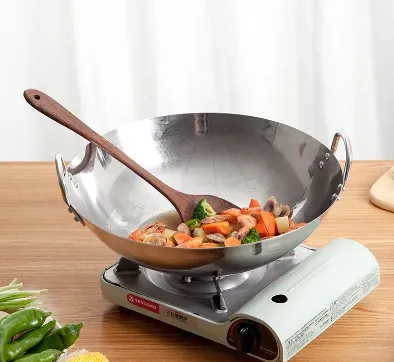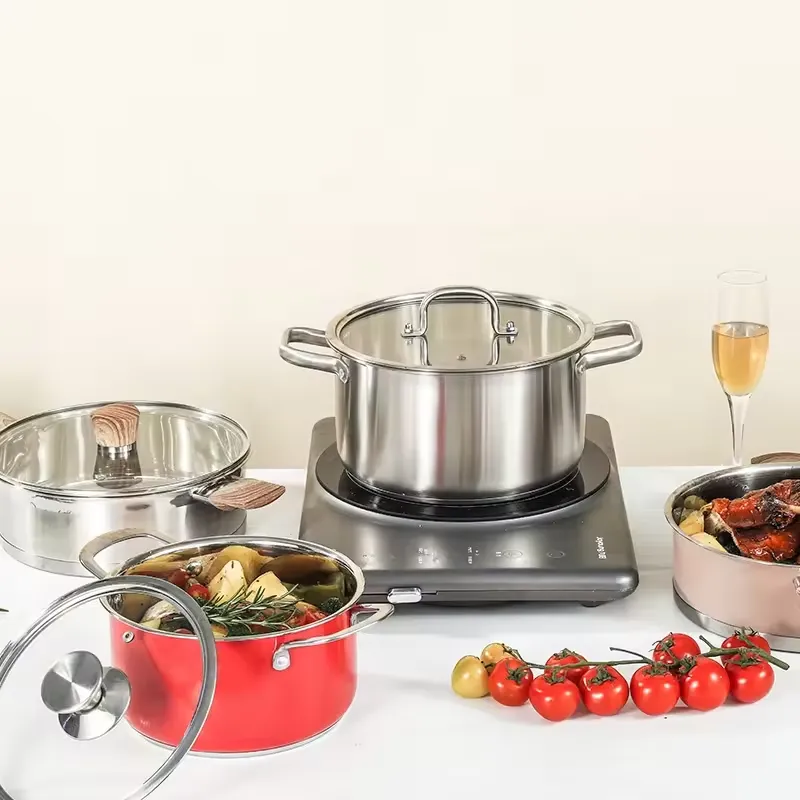Author:蘆花
多くのディストリビューターや中小バイヤーは、以下のどちらかを選択する必要がある。 ステンレス調理器具 そして アルミ調理器具 調理器具を選ぶときどちらが性能に優れ、消費者の期待に応えられるだろうか?実は、この2種類の調理器具にはそれぞれ長所と短所がある。調理器具として 調理器具メーカー 私は30年以上にわたる製造業の経験を生かし、以下のことを深く理解している。 ステンレス調理器具 そして アルミニウム調理器具。
今日の内容は3つのパートに分かれている:
ステンレス調理器具の紹介
アルミ調理器具の紹介
両者の比較
ステンレス調理器具の紹介
ステンレス鋼調理器具は、その耐久性、耐食性、美観のために家庭や商業厨房で広く使用されています。以下は、その詳細な概要である。 ステンレス調理器具:
ステンレスの特徴
耐食性:ステンレス鋼は鉄、クロム、ニッケル、その他の元素からなる合金で、クロム含有量は通常10.5%以上である。クロムは空気中の酸素と反応して緻密なクロム酸化物層を形成し、それ以上の酸化と腐食を防ぐ。
高い強度と耐久性:ステンレス鋼は硬度と強度が高く、大きな機械的圧力や衝撃に耐えることができ、簡単に変形したり損傷したりすることはありません。
非反応性:ステンレス鋼は、ほとんどの食品や調味料に耐性があり、酸性またはアルカリ性の食品と反応しないため、本来の風味を維持し、食品の安全性を確保します。
ステンレス製調理器具の利点:
耐久性がある: ステンレス調理器具 耐久性に優れ、長期間の使用にも容易に破損することがなく、頻繁な使用や過酷な調理環境に適しています。
美しい:ステンレス製の調理器具は金属光沢があり、魅力的で、様々なキッチン装飾スタイルに合わせやすい。
耐食性:ステンレスは水、酸、アルカリに強く、サビや腐食を防ぐので、さまざまな調理法に適しています。
お手入れが簡単:ステンレススチールは表面が滑らかで、食べ物や汚れが付着しにくいので、お手入れが簡単です。 ステンレス調理器具 掃除も手入れも簡単だ。
ステンレス製調理器具の欠点:
熱伝導率が悪い:ステンレスはアルミニウムほど熱伝導率が高くないため、加熱が遅く、ムラが生じます。この状況を改善するため、多くのステンレス製調理器具の底にはアルミニウムや銅の層が埋め込まれています。私たちの ステンレス調理器具 は、ステンレス+アルミニウムの3層構造。2層のステンレスの間にアルミ層を入れることで、熱伝導率がよく、おいしい料理ができる。
重い:ステンレス製調理器具は密度が高いため、通常アルミ製調理器具より重く、使用時に手間がかかる。
コストが高い:製造コストが高いため、ステンレス製調理器具は通常高価である。
ステンレス製調理器具の一般的な種類
シチュー鍋とストックポット:ステンレス製のシチューポットやストックポットは、スープやシチューを作るのに理想的で、耐久性に優れ、お手入れも簡単です。
フライパン、中華鍋:炒め物、揚げ物、煮物、煮込み料理など様々な調理に対応。
包丁:ステンレス製のナイフは切れ味がよく、耐久性に優れている。
当社のステンレス製調理器具:
シチュー鍋をはじめ、各種ステンレス製調理器具を卸している、 スープポット, フライパンそして 中華鍋そして カスタマイズ調理器具ソリューション これらの調理器具はすべて3層構造のコンポジットボトムを使用しており、ステンレスの長所と熱伝導率の良さを兼ね備えている。



アルミニウム調理器具の紹介
アルミニウム調理器具は、そのユニークな素材特性と幅広い用途のため、家庭用および業務用キッチンの一般的な選択肢です。ここでは、アルミニウム調理器具の詳細な概要を説明します:

アルミニウムの特徴
軽量:1立方センチメートルあたり約2.7グラムの密度を持つアルミニウムは、ステンレスや他の金属に比べてはるかに軽く、扱いやすい。
優れた熱伝導性:最大235W/(m・K)の熱伝導率を持つアルミニウムは、素早く均一に加熱されるため、素早く均一な加熱を必要とする調理工程に最適です。
耐食性:アルミニウムが空気に触れると、表面に緻密な酸化皮膜が形成され、それ以上の酸化や腐食を効果的に防ぐ。
アルミニウム調理器具の利点:
素早く均一に加熱:熱伝導率が高いため、食材を素早く均一に加熱し、調理時間を短縮してエネルギー効率を高めます。
軽量で扱いやすい:軽量なので扱いやすく、頻繁に動かしたりひっくり返したりする調理法に最適です。
費用対効果:アルミニウムは豊富で、製造コストも比較的安い。
アルミ製調理器具の欠点:
柔らかく変形しやすい:アルミは比較的柔らかく、使用中に簡単に傷がついたり変形したりするため、重労働や強度の高い調理環境には不向きです。
化学反応性:むき出しのアルミニウムは酸性やアルカリ性の食品と反応し、食品の味や健康に影響を与える可能性があります。この問題に対処するため、多くのアルミニウム製調理器具は保護層(アルマイトやノンスティック加工など)でコーティングされています。
メンテナンスの必要性が高い:アルミニウム製の調理器具は、保護コーティングに傷がつかないよう、また長期間使用できるよう、入念なメンテナンスが必要です。
一般的なアルミ製調理器具の種類:
フライパンと中華鍋:アルミ製のフライパンや中華鍋は火の通りが早く、炒め物に適している。
ストックポットやストックポット:アルミ製のストックポットやストックポットは、熱を均等に伝え、スープやシチューを煮込むのに最適です。
ベーキングトレイとオーブントレイ:アルミ製ベーキングトレイは軽量で熱伝導性に優れ、食品を焼くのに適している。
ステンレス調理器具とアルミニウム調理器具の比較
ステンレス調理器具 は、耐久性、美しさ、お手入れのしやすさ、高い安全性で知られ、キッチンには欠かせない選択肢です。ステンレスの熱伝導率は、ステンレス鋼に比べて比較的低い。 アルミ調理器具の底にアルミニウム層を含む3層のステンレス鋼を追加する。 ステンレス調理器具また、熱伝導率も高い。総合的な性能は、従来のステンレス製調理器具やアルミ製調理器具よりも優れている。例えば PURECOOKステンレス調理器具, その マルチレイヤーボトムはアルミニウム層で埋め込まれている熱伝導率を向上させることができ、設計された調理において完璧な性能を発揮する。一方、アルミニウム製の調理器具は、軽量で熱伝導率がよく、価格も手ごろなため、キッチンでは一般的な選択肢となっている。 アルミ調理器具 は柔らかく、化学反応性が高いため、より正しい使用とメンテナンスが必要となる。
本日のご紹介は以上です!この情報が、アルミ製とステンレス製の調理器具の違いをよりよく理解し、賢い選択をするための一助となり、これらの道具を効果的に使うことで、料理の経験とキッチンの効率が向上することを願っています!
アルミニウムとステンレスの調理器具の見分け方
最初の基準は重量である。.ステンレス鋼は密度が高いので、調理器具は通常重い。アルミニウムは密度が低いので、調理器具は比較的軽い。したがって、調理器具が軽い場合はアルミ製の調理器具であることが多く、その逆はステンレス製の調理器具である。
第二の基準は外観の色である。.ステンレス製の調理器具は通常、より光沢があり、明るい金属の質感を持っています。アルミステンレスの表面はマットです。
第三の基準は、ラベルで判断することである。.ラベルには調理器具の種類が表示されていることが多い。ステンレススチール」や「アルミニウム」などの文字が見えるかもしれません。
第4の基準は、ノック音で判断することである。.ステンレス製の調理器具を叩くと、音は鈍くなり、金属の残響時間は短くなります。アルミ製の調理器具を叩くと、音はより鮮明になり、残響時間は長くなります。

